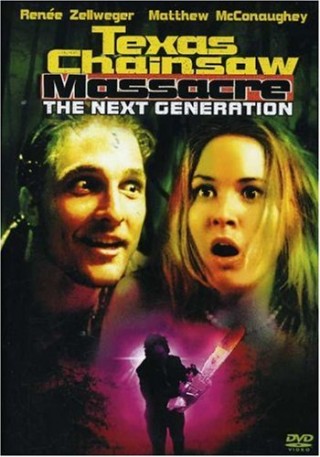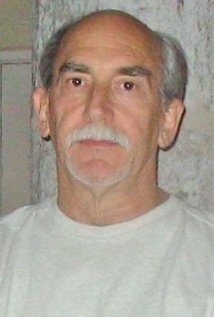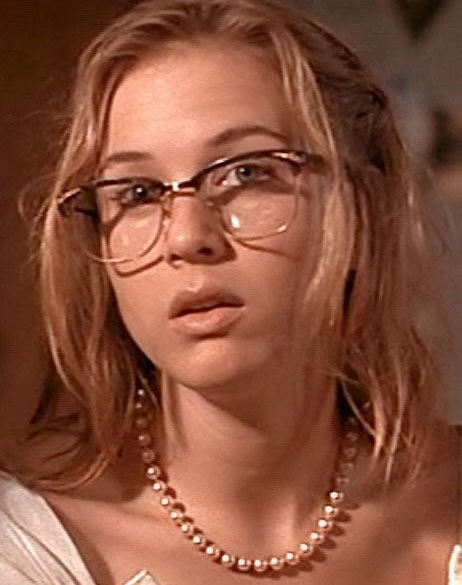
Though I encourage you to go back and read the entire post before you proceed with this follow-up, the basic gist – in a nutshell – is that I feel Henkel was trying to say something with the film that didn’t quite come across.
My interpretation is that the Leatherface clan in the movie works for some sort of mysterious Illuminati organization, and that Henkel was implying they’ve worked for that organization all along.
Here’s a copy and pasted paragraph from the piece, which essentially sums it all up…
The way I see it, The Next Generation is a sort of proto-Cabin in the Woods, tapping into many of the same ideas that Cabin went on to much more effectively tap into, nearly 20 years later. Much like in that film, it’s businessmen in suits who are running the show behind the scenes, essentially creating their very own real-life horror movie. Their intention? To push human beings to the absolute brink of horror, as a sort of sick and twisted experiment.
As I mentioned in that post, my original plan for it was to interview Kim Henkel and relay his vision for the bizarre film, which didn’t quite work out at the time. It seemed he wanted to talk about current projects – including Found Footage 3D – rather than old ones, and in the wake of him passing on the interview, I decided to just write up my own personal take on The Next Generation. Thus, the post that ended up being published.
To my surprise, Henkel got in touch with me not long after the piece went up, and finally agreed to answer the many questions I had sent to him. Just yesterday, the answers arrived in my inbox, allowing for me to now write up the post that I had originally intended on writing up, over a month ago.
What’s most exciting about this is that Henkel has never really opened up about what he was trying to say with the film, thereby making this Halloween Love Exclusive a from-the-horse’s-mouth insight into Texas Chainsaw Massacre: The Next Generation that you quite frankly will not find anywhere else.
From Henkel’s brain to yours, here are the secrets of one of the most bizarre – and fascinating – horror sequels of all time!
“You’re right,” the writer/director began his e-mail, in response to my overall interpretation of the movie. “It is implied that the Illuminati, or an Illuminati-like organization was lurking in the Chainsaw family background. Vilmer calls his wrecker service Illuminati Wrecking. Darla describes the organization Vilmer works for in Illuminati-like terms. And then there’s the appearance of Rothman, a mysterious, Illuminati-like figure.”
“But, at the same time, each of the implications should be suspect,” Henkel continued. “The Illuminati, a notoriously secret society, would not be pleased to have the Illuminati name plastered on the side of some yokels’ wrecker. Darla of the breast implants, and of the purported head implants that explode on cue, can scarcely be considered the most credible of sources. And Rothman; nothing in his behavior suggests his interests are those of a member of a society capable of controlling world events.”
Elaborating on the Rothman character, Henkel offered up a few different interpretations of who he really is…
“He comes off more like the leader of some harum-scarum cult that makes a practice of bringing victims to experience horror on the pretext that it produces some sort of transcendent experience,” Henkel noted. “Of course, it does produce a transcendent experience. Death is like that. But no good comes of it. You’re tortured and tormented, and get the crap scared out of you, and then you die.”
“But, could be Rothman is Illuminati, an astonishingly wealthy and powerful man given to some peculiar personal practices,” he posited. “Seems reasonable enough. And it’s possible the Chainsaw family could serve some useful purpose within the global machinations of the Illuminati. On the other hand, it’s entirely possible Rothman teaches 6th Grade math at a suburban middle school, home nights to a dowdy wife and old maid daughter. Weekends though, he’s Illuminati Man in his best suit and a hired limousine, living out a Walter Mitty life.”
“For me all of the characters in the film, including the family, served as the various forces of authority and culture,” Henkel revealed. “Rothman, or the Illuminati, worked as an authority beyond that of the family. As a sense of a higher, unseen, power that informs the family’s actions and worldview. I was much more interested in the Illuminati as a form of authority — and in what the addition of a Rothman/Illuminati-like character said about the world of the Chainsaw family — than I was in creating a narrative about a Chainsaw family/Illuminati connection.”
“So, although you’re right, the Illuminati implications are definitely there, all that other stuff is in there too,” said Henkel, who it’s worth noting was also the co-creator of Tobe Hooper’s original Texas Chainsaw Massacre.
In his e-mail to me, Henkel talked at length about the character of Jenny, portrayed by a young Renee Zellweger. It is of course Jenny who becomes the film’s final girl, after all of her friends are killed, and his insight into her story offers up a whole lot of insight into the film as a whole.
“Overall the movie is about the Jenny character,” Henkel said. “It’s her story. It’s about her transformation, her refusal to shut up, to be silenced, to be victimized. And by extension her refusal to be oppressed. Even by culture.”
“Within the Chainsaw family’s world certain cultural norms abide that most outside the family culture would deem bizarre, taboo, criminal,” he continued. “I wanted to suggest something about the way culture informs, and misinforms, an individual’s worldview. And something about its power to overwhelm reason.”
“Bringing Jenny into a world in which the culture was grotesquely exaggerated was a way of bringing her to see her own world more clearly – that is to say, my intent was to present a nightmarish version of Jenny’s world in the form of the Chainsaw family in order to enlarge her view of her own world. She came from a dysfunctional family. The Chainsaw family is spectacularly dysfunctional – a nightmarish blowup of Jenny’s own dysfunctional family.”
“Everybody tells Jenny to shut up. After she rejects her stepfathers’ advances, he threatens her with the consequences of speaking out. And again when she calls Barry on his bullshit in the car, he tells her to shut up. Then the Chainsaw family, not only do they want her to shut up, but they want her to buy into their world, to accept their bizarre cultural norms, silly mythologies, and preposterous apocryphal tales. But in the end Jenny tells them, in essence, that they’re full of shit, and she’s walking. Of course, it doesn’t work out all that happily, at least not in the short term. But she does stand up to them, and it’s the beginning of her salvation.”
“Jenny’s a butterfly,” Henkel summed up. “As she emerges from the constraints of oppression, she sheds the constraints of her costume, her guise. When we first see her she’s dressed in a frumpy prom dress, head bowed, hair in her face, cowering behind unflattering glasses. As things progress, she sheds more and more of that costume, parts of the dress, the glasses go, but it’s the Chainsaw family that brings about the final transformation. She appears at the dinner table dressed in glittering finery, hair done-up, make-up impeccable. She’s emerged. She’s awakened. Literally and figuratively. She’s had enough. She’s ready to stand up and fight back.”
Very interesting, as I personally had never given much thought to the Jenny character. Yet another fascinating layer to a film that for so many years was overlooked for being nothing more than a meaningless pile of garbage. Of course, as I stated in my original piece, it’s ultimately a pretty bad movie, but it’s one that’s at least worth re-examining, as Henkel used his own installment of the franchise to say some pretty interesting things.
One aspect of the film that I was unsure of, when I wrote up my interpretation, was the strange reveal of Rothman’s belly, which is outfitted with a few pierced nipples. The conclusion I drew from that is that Henkel was trying to say he’s some sort of inhuman creature, which doesn’t seem to quite be the case.
“I stumbled on a volume about piercing – of an extreme sort — and scarification,” Henkel opened up. “Don’t recall the title. I didn’t intend to suggest Rothman was inhuman. It was more to place him outside of cultural norms, and beyond and above the authority of the Chainsaw family. I’d intended that Vilmer have incipient scarification. The make-up didn’t work out.”
Speaking of Vilmer, played by Matthew McConaughey, I couldn’t help but wonder if he was supposed to be the Hitchhiker character from the original film, which is something I asked Henkel, but didn’t get into in my piece.
He cuts himself much the same way the Hitchhiker did and appears to have had a serious injury in the past, which all fits in line with him perhaps being the same character.
“Vilmer was kind of a reincarnation of the Hitchhiker,” Henkel revealed, though that’s all he had to say about that particular subject. I guess it’s not so much that Vilmer was supposed to be the Hitchhiker, but rather that he was Hitchhiker 2.0, so to speak.
The last question I had for Henkel was in regards to the film’s final moments, which feature a few cameos from original Chainsaw cast members. I wondered if they – particularly Marilyn ‘Sally Hardesty’ Burns – were thrown in there simply for the purpose of ending the film with some fun cameos, or if there was more to that moment where Burns is wheeled past Jenny on a hospital gurney.
“It was intended to convey an emotional connection between the Sally character and the Jenny character, a kind of perverse passing of the torch,” Henkel responded, confirming that it was in fact supposed to be Sally Hardesty we saw in those final moments, and not just Marilyn Burns playing a random patient. Just a little something I always wondered, since she’s only credited as ‘Woman on Hospital Gurney.’
And there you have it. The secrets/mysteries of The Next Generation, finally revealed. Armed with this knowledge, I encourage you to re-watch the film with a different set of eyes than you’ve ever watched it with before, and then come on back and let us know what you make of it all.
Again, not saying it’s a underrated gem, but there certainly is more to the whacky installment than meets the eye!
Support Halloween Love
If an item was discussed in this article that you intend on buying or renting, you can help support Halloween Love and its writers by purchasing through our links:
(Not seeing any relevant products? Start your search on Amazon through us.)



